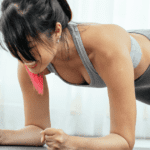A question I see get asked a lot is “what is flow yoga?”
Flow yoga matches the breath to movements as you seamlessly flow through a series of asanas or yoga postures. While it’s not confined to one particular type of yoga, the most common is Vinyasa Flow.
Flow classes typically feature music and focus on breath work, and can be either vinyasa-based or hatha-based. It’s a very dynamic practice with a series of poses that can easily be modified for various levels of experience. The instructor will take you through a series of sun salutations and poses like downward-facing dog, plank, upward dog, warrior, chair, and some floor poses.
If you’re new to flow yoga, expect a fun and challenging workout that will leave you feeling invigorated! If you’re interested in yoga for weight loss, check out this article.
What is flow yoga good for?
Flow yoga offers many physical and mental benefits, including:
Reducing stress and anxiety
With the focus on matching breath to the movements, you may find that you’re able to breathe more deeply and let go of worries and stressors from the day. This deep breathing may also increase your lung capacity over time.
Muscle and joint flexibility
You can expect your flexibility to improve when you practice flow yoga. The series of poses not only focus on building strength, but also on stretching your muscles to increase your range of motion.
Core strength
Flow yoga typically includes a lot of plank poses, as well as dynamically flowing from plank to downward facing dog, then back to plank. These moves will help strengthen your core, which will improve your posture.
Stability and balance
Along with core strength comes better stability and balance. Your instructor may also include balancing poses such as tree, warrior three, or half-moon poses. These will improve your stability and balance.
Endurance and strength
If you participate in a faster-paced flow yoga, like Vinyasa, you’ll get a good cardio workout while building strength.
Back & neck pain
The origins of yoga are from over 5,000 years ago in India. Yoga practitioners went through a series of stretching, bending, and twisting poses to allow them to sit through hours of meditation (without back & neck pain!)
Sleep
The combination of releasing stress, breathing deeply, and working out your muscles is sure to give you a great night of sleep!
What is Vinyasa Flow yoga?
Vinyasa is the style of flow that follows a set sequence of postures linked together by the breath. It requires grace and movement to transition between poses, resulting in an energized, continuous flow of movement. It generally is dynamic and faster-paced, building in intensity through the first half of the class. But then it comes back down to a more relaxing pace towards the end.
What is Hatha Flow yoga?
Hatha flow yoga, on the other hand, is slower-paced and focuses more on breathing for relaxation. It may also include meditation. Poses are held for several breaths before moving to the next, allowing for an enhanced state of relaxation and mindfulness. These poses are also designed to strengthen and stretch your muscles while improving your flexibility.
What can you expect in a flow yoga class – from the warm-up to the cool-down
When attending a flow yoga class, there are certain steps you can expect from the moment you arrive until your practice comes to an end. Generally, at the beginning of class, you will be invited to move through some warm-up poses to settle into your practice and enable your body to prepare for more vigorous movements that may come later.
During the class itself, you will be guided through a combination of breathwork and creative physical sequences that are designed to help develop strength, flexibility, and balance. Music might also form part of the atmosphere and be played throughout the session. At times during this part of the class, faster heartbeats and even sweating may take place once some intensity has been reached in body postures or movements. Finally, as you near the end of class, you’ll get to experience moments of quiet meditation followed by some cool-down poses that signal a return to rest – embracing how far you have come in your practice so far!
Tips for getting the most out of your flow yoga practice
Everyone’s flow yoga practice is unique, but there are a few tips you can follow to ensure you get the most out of it. Firstly, develop a routine that works for you – this could include warming up, selecting a specific type of yoga for each day (e.g. vinyasa flow or hatha flow), setting goals, and allowing yourself time to relax and cool down afterward. Secondly, be mindful and stay in the present moment – listen to your body during each posture, including any discomfort or difficulty with breathing. Thirdly, use props when necessary; blocks, straps, and bolsters can be used to tailor postures to your level and offer greater stability within your practice. Finally, always remember that even if you don’t reach all your goals each session, practicing patience and self-love should be at the top of your list!


